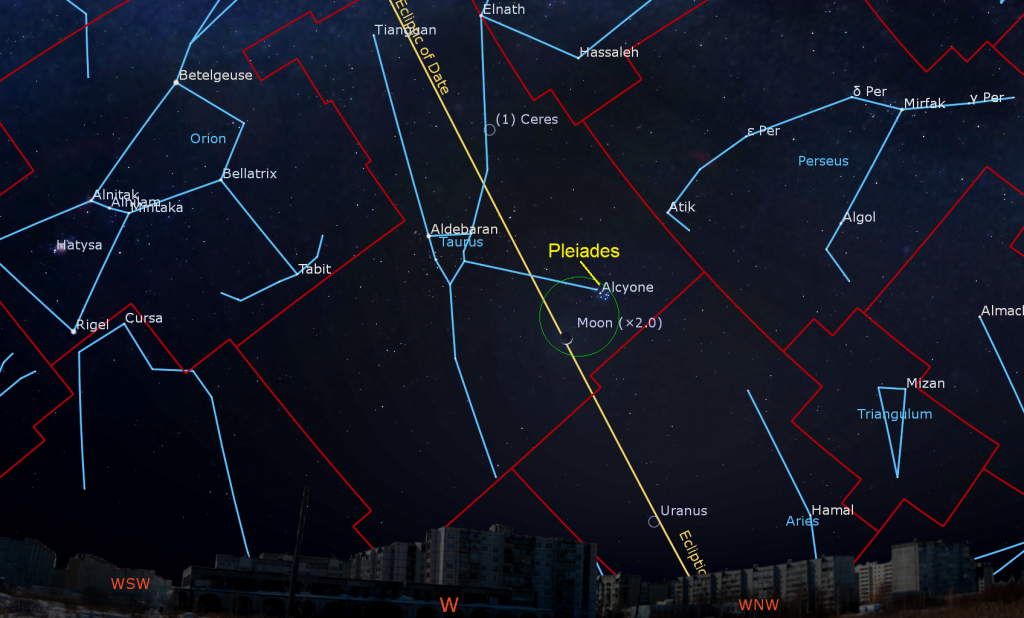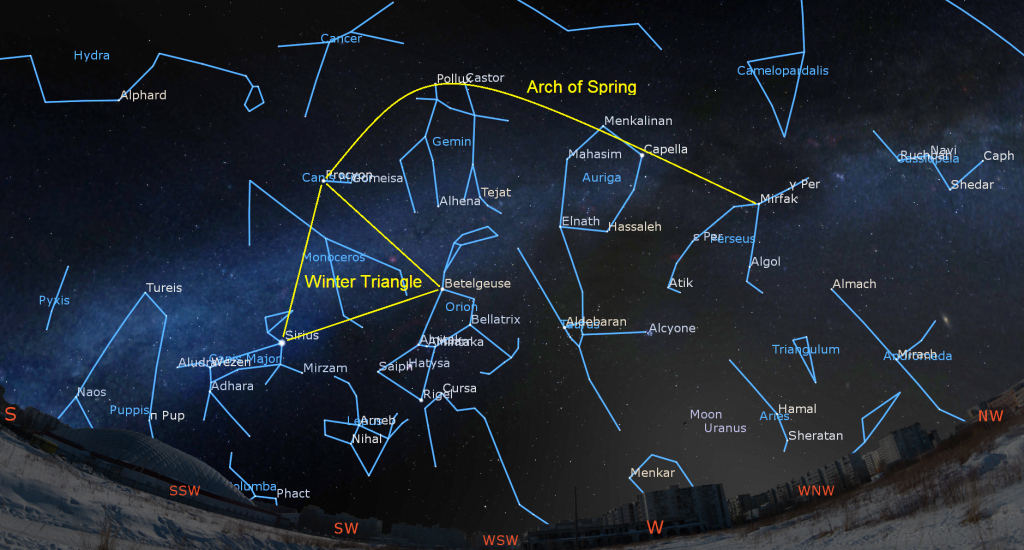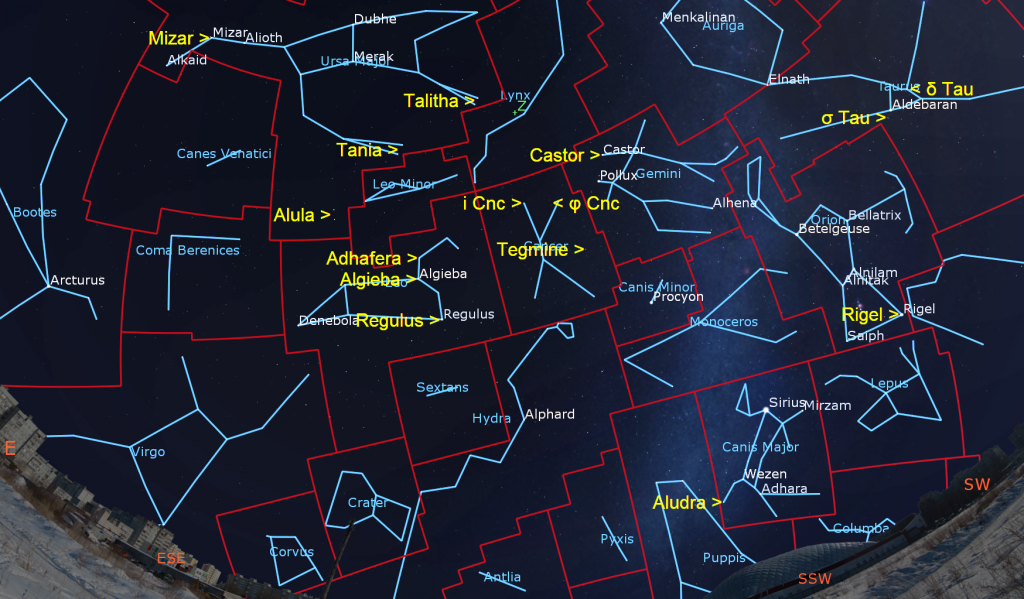Morning Mars Kisses Saturn, A Waxing Moon Travels Taurus, and Some Bright Delights!

The moon at its first quarter phase, imaged by Michael Watson of Toronto in mid-twilight on April 22, 2018. The nights surrounding first quarter on Saturday, April 9 are the best ones for evening views of the moon through binoculars and any size of telescope.
Welcome to International Astronomy Month, April Stargazers!l Stargazers!
Here are your Astronomy Skylights for the week of April 3rd, 2022 by Chris Vaughan. Feel free to pass this along to your friends and send me your comments, questions, and suggested topics. You can also follow me on Twitter as @astrogeoguy! Unless otherwise noted, all times are expressed in Eastern Time. To subscribe to these emails please click this MailChimp link.
If you’d like me to bring my Digital Starlab portable inflatable planetarium to your school or other daytime or evening event, or deliver a session online, contact me through AstroGeo.ca, and we’ll tour the Universe, or the Earth’s interior, together! My terrific new book with John A. Read entitled 110 Things to See With a Telescope is a guide to viewing the deep sky objects in the Messier List – for both beginners and seasoned astronomers. DM me to order a signed copy!
The young crescent moon will pass Ceres and several treats in Taurus during evening this week. I also share some suggestions for non-moon evening targets. The bright planets party in the eastern predawn sky levels up with Jupiter (and Neptune), and very bright Venus watching Mars kiss Saturn before dawn on Monday and Tuesday. Read on for your Skylights!
The Moon
The moon’s new phase that occurred on Friday marked the start of Ramadan, the ninth month of the Islamic calendar. Because that calendar is lunar based and not linked to the Earth-sun system, it shifts (earlier) by about 10 days with each passing year, compared to our sun-based Gregorian calendar. Each Islamic month commences when the Hilāl, or crescent moon, is first sighted in the western post-sunset sky from Mecca following a new moon phase. Mecca, or Makkah, is located east of the Red Sea in Saudi Arabia – at latitude 29° 25’ 21” North.
Observing Ramadan is regarded as one of the Five Pillars of Islam. Among other practices, observers are required to fast from sunrise to sunset. But the length of daylight varies considerably with latitude – so Muslims living at high northern latitudes, where the daylight period can reach 22 hours in length in summer, follow the timetable of Mecca, where the daylight hours only last about 12 hours and 40 minutes during April. (That situation will repeat for Southern Hemisphere Muslims in years when Ramadan eventually follows their spring equinox in September.)
In 2022 Ramadan commenced at sundown on Friday, April 1. The holiday of Eid al-Fitr, or just Eid, marks the end of Ramadan and the beginning of Shawwal, the next Islamic lunar month, on Monday, May 2.
Since the moon has just passed the sun, Luna will begin this week shining as a slender crescent in the western sky after sunset. Its continuous eastward orbital motion around Earth will increase its angle from the sun by about 12 degrees per day, causing it to wax in illuminated phase and set about an hour later every night. This will be the best week of the lunar month for viewing the moon in binoculars or any size of telescope. The terrain to the right (lunar east) of the pole-to-pole terminator boundary will be spectacularly lit by slanted sunlight. New zones will be highlighted each night as the terminator marches west.
Tonight, (Sunday Sunday, April 3), the young crescent moon will pass binoculars-close to the faint, magnitude 5.85 planet Uranus, in Aries (the Ram). In the Eastern Time Zone look for Uranus’ blue-green dot positioned two finger widths below, and slightly to the right (or 2 degrees to the celestial west) of the moon. In more westerly time zones their separation will be greater. Hours earlier, observers in the Côte d’Ivoire region of Africa can see the moon cross in front of (or occult) Uranus around 19:30 Greenwich Mean Time.

Waxing crescent moons rise during in the daylight hours. Once the moon’s illuminated portion becomes substantial, you can spot in the daytime sky without too much trouble. Binoculars will help, but keep them aimed away from the sun. (Parental supervision is important for youngsters scanning the sky with binoculars or telescopes in daytime.)
On Monday night, the moon will linger beyond dusk, allowing you to see it shining prettily in Taurus (the Bull). The bright Pleiades star cluster will be positioned just a few finger widths to the upper right (celestial north) of the moon until they set in late evening. They’ll share the field of view in your binoculars and make a pretty picture. Let me know if you capture them! Don’t forget to include Taurus’ brightest star, orange-tinted Aldebaran, which will sparkle off to their upper left (celestial southeast). On Tuesday night, the moon will hop east, landing above and between those objects. For observers in the Americas that night, the dwarf planet (formerly asteroid) designated (1) Ceres will be located nearly a palm’s width above the moon (or 5 degrees to its east). About 10 hours later, observers in the region around Thailand and Singapore can see the moon occult Ceres.
The moon will spend Wednesday night between Taurus’ horn-tip stars. The southern horn Zeta Tauri will shine on the moon’s left, and twice-as-bright Elnath will appear on the moon’s right, or celestial north. In reality, Zeta emits much more light than Elnath; but it’s three times farther from us (445 light-years), so it looks fainter.

On Thursday night, the 38%-illuminated crescent moon will pass a few finger widths above the bright stars that make up the toes and feet of Gemini (the Twins). Position the moon at the top of the field in your binoculars and look for a hazy clump of stars well below it. That’s the big open star cluster named Messier 35, NGC 2158, or the Shoe-Buckle Cluster. It’s almost 2800 light-years away from us! A prominent star named Propus sits just to the left (or 2.2 degrees to the celestial southeast) of the cluster. Using Propus, you can always find the shoe-buckle without the moon around.
The moon will reach its first quarter phase on Saturday morning at 2:48 am EDT (or 06:48 GMT). At first quarter, the relative positions of the Earth, sun, and moon will cause us to see our natural satellite half-illuminated – on its eastern side between about noon and midnight. Hours earlier, observers in Europe and western Africa, can see the Lunar X and Lunar V shapes on the moon. The Lunar X is located on the terminator, about one third of the way from the southern pole of the Moon, at lunar coordinates 2° East, 24° South. The Lunar V is along the northern span of the terminator near the crater Ukert. Both are predicted to start developing by about 9 pm British Summer Time (or 20:00 GMT), peak in intensity around 11 pm BST (or 22:00 GMT), and then gradually fade out during the following 90 minutes. The Lunar X and V will be visible anywhere on Earth where the moon is shining, especially in a dark sky, between 20:00 GMT on April 8 and 00:00 GMT on April 9.

The waxing gibbous moon (i.e., slightly more than half-lit) will shine among the faint stars of Cancer (the Crab) on Saturday and Sunday night. On Sunday, use your binoculars to see the huge open star cluster named Messier 44, NGC 2632, and the Beehive Cluster sitting less than a palm’s width to the moon’s lower right (celestial southwest). The moon passes through, or close to, this cluster frequently because the Beehive is located only 1 degree north of the ecliptic, the great circle that the sun, moon, and planets travel close to. To better see the “bees”, try placing the bright moon just outside the field of view of your binoculars. Observers in Europe and Africa (GMT +2 hours) will see the moon while it’s closest to the cluster.
The Planets
The bright planets party in the eastern pre-dawn sky is really ramping up now that Jupiter has climbed higher! The fun starts shortly after 5 am in your local time zone when three planets all rise together. Look for yellowish Saturn shining near reddish Mars to the left (celestial east) of the modest stars of Capricornus (the Sea-Goat). Much brighter Venus will gleam to their left in next-door Aquarius (the Water-Bearer). By 6 am, the trio should be high enough to see as a nice little row. They’ll just barely share the field of view of binoculars on Monday morning – but Venus’ eastward rapid motion sunward will outpace the other two planets, causing their line to stretch out with each passing day.
Meanwhile, starting on Monday morning, the faster orbital motion of Mars will see it pass Saturn in a very close conjunction. They will be cosy enough to share the eyepiece in a backyard telescope from Sunday to Wednesday. On Monday, Mars will be positioned less than a finger’s width to the right (or only half a degree to the celestial southwest) of Saturn. At their closest approach on Tuesday morning, Mars will be just below Saturn (or 0.3 degrees to the ringed planet’s celestial southeast). Your telescope may flip and/or invert that arrangement. Next Sunday, Venus will gleam 1.2 fist diameters to the left (or 12.5 degrees to the celestial east) of Saturn, with Mars between them.

While the brightening sky will hide Mars and Saturn before long, Venus will remain in sight past 6:30 am. In a telescope Venus will exhibit a half-illuminated, waxing gibbous phase that even good binoculars can reveal. Any size of telescope will show you Saturn’s full globe, its rings, and perhaps a few moons, while Mars will exhibit a tiny, 92%-illuminated disk. (Be sure to turn all optics away from the eastern horizon before the sun rises.)
This week, the bright dot of Jupiter will clear the horizon by about 6 am local time. It’ll become higher and easier to see each morning. As a locating aid, note that Venus and the other two planets will be arranged to Jupiter’s upper right (celestial west) – decreasing from 23.5° away on Monday to 18° away next Sunday. Jupiter will be approaching from the right (celestial west) the dim planet Neptune this week. They’ll be telescope-close starting next Sunday. Observers located closer to the tropics will see Jupiter (and potentially, Neptune) more easily.
Uranus is the only planet remaining in the evening sky, but decent telescope viewing opportunities have ended until it returns to visibility in the eastern pre-dawn sky at the end of June.
Not to be outdone by the moon, dwarf planet (1) Ceres will itself travel a thumb’s width to the right (or 1.5 ° to the celestial north) of an open star cluster named NGC 1746 on the coming weekend.
Moon-friendly Sights
I’ve often highlighted sights to see on the waxing moon, but we don’t need to ignore the rest of the sky!
If you are outside around 9:30 pm local time on a clear evening this week, watch for Sirius (Alpha Canis Majoris), the brightest star in the night sky. It will show glints of primary colours as it twinkles fiercely over the southwestern horizon. You may need to walk about to find an unobstructed view of it. Shining at almost the same elevation, but over in the eastern sky will be the bright, orange-tinted star Arcturus in Boötes (the Herdsman). The name Arcturus arises from the Greek word for “bear” αρκούδα (arkoúda), because it follows Ursa Major (the Big Bear) around the North Celestial Pole. (It’s also where our word arctic comes from. The place is named after the polar bear, and not the other way around.) Arcturus is the fourth brightest star in the night sky.
Several prominent winter asterisms persist into early April. During early evening the Winter Hexagon is tilting over the southwestern horizon. Also known as the Winter Circle and Winter Football, it is composed of (moving anti-clockwise from the bottom left) bright white Sirius (Alpha Canis Majoris), blue-white Rigel (Beta Orionis), orange Aldebaran (Alpha Tauri), yellow Capella (Alpha Aurigae), white Castor and golden Pollux (Alpha and Beta Geminorum respectively), and white Procyon (Alpha Canis Minoris).

Some people use the top stars of the Winter Hexagon to make another pattern called the Arch of Spring, adding in the fainter star Menkalinan near Capella, and continuing the curve past Capella to the bright star Mirfak in Perseus (the Hero). Others have used Sirius, Betelgeuse, and Procyon to form another asterism called the Winter Triangle.
Turning around and looking the other way, the constellation of Leo strongly resembles the lion that it is named for. Already stalking the eastern sky at nightfall, the beast is an all-night constellation. Its heart is marked by white Regulus, its brightest star. Regulus also serves as the point on the backwards question mark asterism, also known as the Sickle, which forms the lion’s neck and head. Algieba (Gamma Leonis) is the medium-bright star that marks the lion’s throat, and is an easy double star in small telescopes. Regulus and Adhafera, which marks the lion’s ear, are other double stars.
Speaking of double stars, the dim constellation of Cancer (the Crab) sits nearly overhead in the southern sky during mid-evening. It contains quite a few nice multiple stars that make ideal binocular or telescope targets on moonlit nights. Phi Cancri (φ Cnc) is a very wide double easily seen in binoculars. Zeta Cancri (ζ Cnc), also known as Tegmine, is a spectacular triple of yellow stars located 83 light-years from Earth. And, Iota Cancri (i Cnc), or Zubanah, is a fantastic golden and blue pair visible in telescopes.

For a much easier double, try Mizar, the star where the handle of the Big Dipper bends. Its small companion star Alcor is obvious with unaided eyes. Even better, aim your telescope at Mizar for a real treat! While you are in that neighbourhood, look for the Three Leaps of the Gazelle, the widely-spaced pairs of Talitha, Tania, and Alula situated below the dipper. And check out Aludra, the tail star of Canis Major (the Big Dog).
Public Astro-Themed Events
Every Monday evening, York University’s Allan I. Carswell Observatory runs an online star party – broadcasting views from four telescopes/cameras, answering viewer questions, and taking requests! Details are here. They host in-person viewing on the first clear Wednesday night each month. Other Wednesdays they stream views online via the observatory YouTube channel. Details are here.
On Tuesday, April 5 from 7 to 8 pm EDT, the Dunlap Institute at University of Toronto will stream their popular Astro Trivia Night. The live, free event will feature lots of fun and prizes. Details are here.
On Wednesday evening, April 6 at 7:30 pm EST, the RASC Toronto Centre will live stream their monthly Recreational Astronomy Night Meeting at https://www.youtube.com/rasctoronto/live. Talks include The Sky This Month, Celestron’s smartphone-assisted telescopes, and how asteroids are named. Details are here.
Eastern GTA sky watchers are invited to join the RASC Toronto Centre and Durham Skies for solar observing and stargazing at the edge of Lake Ontario in Millennium Square in Pickering on Friday evening, April 8, from 6 pm to 11 pm. Details are here. Before heading out, check the RASCTC home page for a Go/No-Go call in case it’s too cloudy to observe. The rain date is Saturday.
On Saturday night, April 9 from 7:30 to 8:30 pm EDT, RASC Toronto Centre, RASC National, and the Canadian Space Agency will live stream a celebration of the NASA Artemis Mission to return humans to the moon, and Canada’s contributions. Join me and several outstanding science outreach specialists as we share information about the moon and the mission, and RASC astronomers will broadcast live views of the moon through their telescopes. Details are here, and watch on YouTube here.
Public sessions at the David Dunlap Observatory may not be running at the moment, but RASC are pleased to offer some virtual experiences instead in partnership with Richmond Hill. The modest fee supports RASC’s education and public outreach efforts at DDO.
On Friday night, April 8 from 8 to 9:30 pm EDT, the DDO Astronomy Speakers Night program will feature Dr. Michael Reid, Associate Professor, Teaching Stream in the Department of Astronomy and Astrophysics at the University of Toronto. He’ll speak on The Search for Another Earth. There will also be a virtual tour of the DDO and live-streamed views from the DDO’s 74-Inch telescope (weather permitting). Only one registration per household is required. Deadline to register for this program is Wednesday April 6, 2022 at 3 pm. More information is here and the registration link is here.
On Sunday afternoon, April 10 from 11 am to noon EDT, join me for Ask an Astronomer. During these family-friendly sessions, I’ll answer your questions about the universe and review what’s up nowadays. Only one registration per household is required. Deadline to register for this program is Wednesday, April 6, 2021 at 3 pm. Prior to the start of the program, registrants will be emailed the virtual program links. The registration link is here.
My free, family-friendly Insider’s Guide to the Galaxy webcasts with Samantha Jewett of RASC National returns on Tuesday, April 12 at 3:30 pm EDT, when we’ll talk about a fascinating topic in astronomy and continue with our Messier Objects observing certificate program. You can find more details and the schedule of future sessions here.
Don’t forget to take advantage of the astronomy-themed YouTube videos posted by RASC Toronto Centre and RASC Canada.
Keep looking up, and enjoy the sky when you do. I love questions and requests. Send me some!